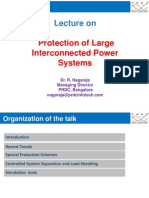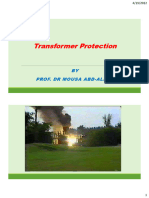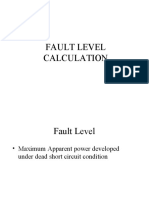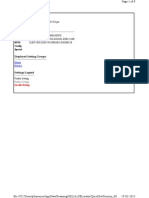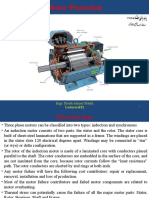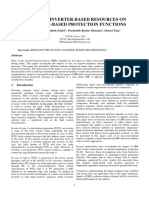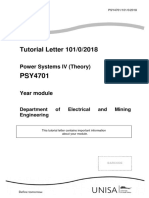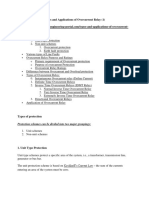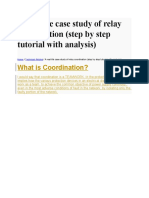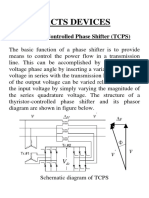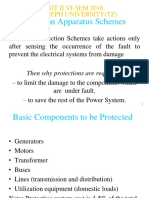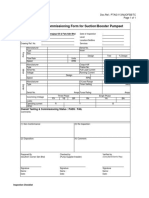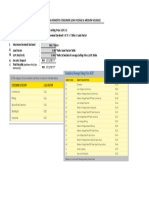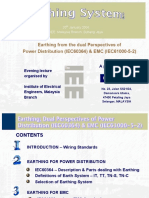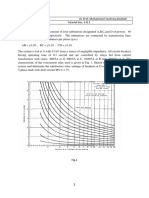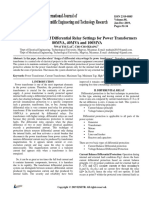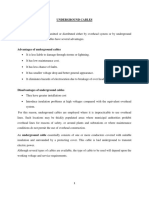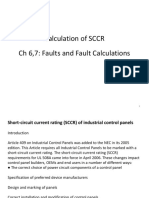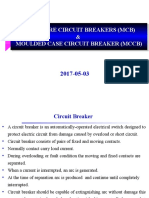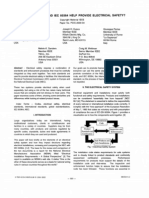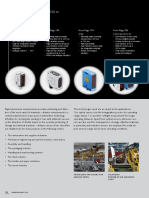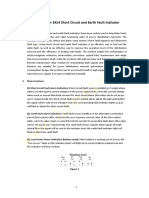Power System Protection Part – X Dr.Prof.
Mohammed Tawfeeq Alzuhairi
GENERATOR PROTECTION
MOTOR PROTECTION
BUS PROTECTION
851
�Power System Protection Part – X Dr.Prof. Mohammed Tawfeeq Alzuhairi
GENERATOR PROTECTION
The generator protection system design should take into account
the types of faults and abnormal operating conditions that could be
present at the generating plant and provide means for detecting and
acting upon these conditions. The protection system design will
depend on the size of the generating unit.
These fault types and disturbance conditions are classified as:
Overload protection, and Overcurrent (short-circuit) problems
Stator electrical faults
Rotor electrical faults
Failure of prime mover (mechanical problems)
Failure of the field circuit
Hence we must protect the generator against the effect of these faults
and abnormalities using the following protection schemes:
Overload protection, and Overcurrent protection
Overvoltage and undervoltage protection
Overexcitation
Unbalanced loading (Currents ) –sequence relay
Loss of Excitation
Loss of synchronism
Phase Faults
Earth Faults
Abnormal Frequencies
Motoring
Overspeeding
Excessive vibration
Internal faults,
Stator and rotor thermal protection, and
Field ground.
851
�Power System Protection Part – X Dr.Prof. Mohammed Tawfeeq Alzuhairi
1. Generator protection using differential protection
schemes
To protect the generator against the failure of winding insulation and the
failure of the field circuit as well as the primemover failures, differential
protection is used with biased circulating current scheme. The theory of
circulating current differential protection is discussed fully in part 7. The
protection scheme is shown in Fig.1.Normally differential protection is
used for generators larger than or equal to 20MW.
Figure 1: Stator biased differential protection for generator.
Example 1
Figure 2 shows a biased percentage differential relay applied for the
protection of synchronous generator windings. The relay has 0.1A
minimum pick up current and a 10 %.
(a) Fault has occurred near the grounded neutral end of the generator
when the generator is carrying load. As a result, the currents flowing at
each end are as shown in the figure. Would the relay operate or not?
(b) would the relay operate at the given value of fault current in (a)
above mif the generator was carrying no load ?
(c ) On the same diagram , show the relay opersting characteristics and
the points that represent the operating and restraining currents in the
relay for the two conditions.
861
�Power System Protection Part – X Dr.Prof. Mohammed Tawfeeq Alzuhairi
Fig.2
868
�Power System Protection Part – X Dr.Prof. Mohammed Tawfeeq Alzuhairi
861
�Power System Protection Part – X Dr.Prof. Mohammed Tawfeeq Alzuhairi
Typical generator protection scheme is shown in Fig.4 below:
Relay 51N or 51GN : Time overcurrent earth fault in the neutral
Fig.4 Generator Protection Application Simplified One-Line Diagram
861
�Power System Protection Part – X Dr.Prof. Mohammed Tawfeeq Alzuhairi
GENERATOR PROTECTION APPLICATIONS
PHASE FAULT PROTECTION
Phase faults in a generator stator winding can cause thermal damage to
insulation, windings, and the core, and mechanical torsional shock to
shafts and couplings. Trapped flux within the machine can cause fault
current to flow for many seconds after the generator is tripped and the
field is disconnected.
GROUND-FAULT PROTECTION
One of the main causes of ground faults is insulation failure. The zero
sequence impedance of a generator is usually lower than the positive or
negative sequence impedance, and hence, for a solidly grounded
generator, the single phase to ground-fault current is greater than the
threephase fault current. To limit the ground-fault current, generators are
usually grounded through an impedance.
LOSS-OF-FIELD (EXCITATION) PROTECTION
Loss of excitation on a synchronous machine can be caused by operator
error, excitation system failure, a short in the field leads, accidental
tripping of the field breakers, or flashover of the exciter commutator.
When the machine loses its excitation, the rotor accelerates and the
synchronous machine operates as an induction generator. As a result,
the machine draws inductive reactive power from the system instead of
supplying it to the system. Also heavy currents are induced in the rotor
teeth and wedges and can cause thermal damage to the machine if the
machine continues to operate.
OVEREXCITATION PROTECTION
When the ratio of the voltage to frequency (volts/Hz) exceeds 1.05 pu for
a generator, severe overheating can occur due to saturation of the
magnetic core of the generator and the subsequent inducement of stray
flux in components not designed to carry flux. Such overexcitation most
often occurs during start-up or shutdown while the unit is operating at
reduced frequencies, or during a complete load rejection which leaves
transmission lines connected to the generating station. Failure in the
excitation system can also cause overexcitation. Similar problems can
occur with the connected transformer.
861
�Power System Protection Part – X Dr.Prof. Mohammed Tawfeeq Alzuhairi
OVERVOLTAGE PROTECTION
Generator overvoltage may occur during a load rejection or excitation
control failure. In case of hydrogenerators, upon load rejection the
generator may speed up and the voltage can reach high levels without
necessarily exceeding the generator’s V/Hz limit. The overvoltage
relay(59) is used to protect the generator from this condition.
UNBALANCED CURRENTS
Unbalanced faults and other system conditions can cause unbalanced
three-phase currents in the generator. The negative sequence
components of these currents cause double-frequency currents in the
rotor that can lead to severe overheating and damage. The negative
sequence overcurrent function (46) is provided to protect the unit before
the specified limit for the machine is reached.
ABNORMAL FREQUENCY PROTECTION
Over Frequency Protection
Full or partial load rejection can lead to overspeed of the generator, and
hence, over frequency operation. In general, over frequency operation
does not pose any serious problems and control action can be taken to
reduce the generator speed and frequency to normal without tripping the
generator. Generators are shipped with overspeed detectors. An over
frequency relay can be used to supplement this overspeed equipment.
The multifunction relays provide a two-setpoint over frequency relay
(device 81O) that can be set to alarm or trip on an over frequency
condition.
Under Frequency Protection
Overloading of a generator, perhaps due to loss of system generation
and insufficient load shedding, can lead to prolonged operation of the
generator at reduced frequencies. This can cause particular problems
for gas or steam turbine generators, which are susceptible to damage
from operation outside of their normal frequency band.
The turbine is usually considered to be more restrictive than the
generator at reduced frequencies because of possible mechanical
resonance in the many stages of the turbine blades. If the generator
speed is close to the natural frequency of any of the blades, there will be
an increase in vibration. Cumulative damage to the blades due to this
vibration can lead to cracking of the blade structure.
865
�Power System Protection Part – X Dr.Prof. Mohammed Tawfeeq Alzuhairi
MOTOR PROTECTION
1. General
Fuses , thermal overload relay and contactors has proved itself an
effective and economical solution for small to medium-sized motors up
to about 150 hp.Two basic protections are used for these motor:
■ Thermal overload protection
■ Short-circuit (overcurrent) protection
On larger, more expensive motors or when maximum motor utilization is
required under varying operational conditions more sophisticated flexible
and accurate microprocessor protection relays
should be considered. These relays typically include:
■ Thermal overload protection,
■ Short-circuit protection
■ Start-up and running stall protection
■ Phase unbalanced protection
■ Single-phasing protection
■ Earth fault protection
■ Undercurrent protection
The present day concept is use of microprocessor-based numerical
relays for both HV and LV motors (say beyond 50 kW), as the relays
come with lot of features which allow them to be interchangeable,
ensures site settings and give valuable feedback on the load details
whether a trip occurs or not.
2. Typical protective settings for motors
(a) Long- time pick-up
• (1.15) times motor full load current (FLA) times motor service factor for
applications,encountering 90% voltage dip on motor starting
• (1.25) times motor FLA times motor service factor for applications
encountering 80% voltage dip on motor starting.
(b) Long-time delay
• Greater than motor starting time at 100% voltage and the minimum
system voltage
• Less than locked rotor damage time at 100% voltage and the minimum
system voltage
866
�Power System Protection Part – X Dr.Prof. Mohammed Tawfeeq Alzuhairi
• On high-inertia drives, it is common for the start time to be greater than
the locked rotor withstand time. Under these circumstances, set the time
to permit the motor to start. Supplemental protection should be added for
locked rotor protection. One example of this is a speed switch set at
25% of rated speed tripping through a timer to trip if the desired speed
has not been reached in a pre-determined time.
(c) Instantaneous pick-up
• Not less than 1.7 times motor long-time pick up rated ampere (LRA) for
medium-voltage motors
• Not less than 2.0 times motor LRA for low-voltage motors.
(d) Earth-fault protection
• Minimum pick-up and minimum time delay for static trip units
• Core-balance CT and 50 relays set at minimum for medium-voltage,
low-resistance grounded systems
• Residually connected CT, and 50/51 for medium voltage, solidly
grounded systems. Minimum tap and time dial equals 1 for 51 relay
• Minimum tap (not less than 5 A) for 50 relay.
Motor protective device
Molded Case Circuit Breakers (MCCB) are used for low voltage
motors of high ratings.
Miniature circuit breakers (MCB) for small motors.
Fuses + contactor + thermal relay for L.V motors.
For high voltage motor: H.V. circuit breaker and differential
protection.
861
�Power System Protection Part – X Dr.Prof. Mohammed Tawfeeq Alzuhairi
Example
861
�Power System Protection Part – X Dr.Prof. Mohammed Tawfeeq Alzuhairi
Motors protection by fuses
In several industrial applications, fuses are used for protecting small and
medium size motors. To determine the fuse size for a motor, one should
refer to Fig. 1 which shows typical fuse time/current characteristics.
These characteristics represent fuse operation where the current is
insufficient to operate the fuse in the first 1/4 - cycle,or 0.005 s in a 50
Hz system.
Fig. 1.9 Fuse time/current characteristics
If the starting current of the motor is say 500 A and the run-up time 10s,
then a 125 A fuse would be required. Examination of the fuse
time/current characteristic shows that at 500 A the 125 A fuse would
operate in 15 s. The fuse one size lower, 100 A, would operate in 4 s at
500 A and is, therefore, not suitable. The full-load current of the motor
would be, say, 83 A and although a 100 A fuse would deal with this
current it could not deal with the starting current for the duration of the
starting time. The fuse does not protect the motor against overload as
the rating of the fuse is always two to three times the full load current.
861
�Power System Protection Part – X Dr.Prof. Mohammed Tawfeeq Alzuhairi
Fig. 2 Composite time/current curves
To summarize
1 .The fuse must be adequately rated to supply normal current to the
circuit.
2. The rating must take into account any normal healthy overload
conditions e.g. the starting of motors.
3. An allowance must be made if an overload occurs frequently.
4. There must be an adequate margin if discrimination between fuses is
required.
5. The fuse must protect any equipment which is not rated at the full
short-circuit rating of the power system, e.g. contactors, cables,
switches, etc.
Example of fuse selection
A 415 V distribution system is shown in Fig. 3.
Lighting load - 20 kW
Select a 32 A fuse.
811
�Power System Protection Part – X Dr.Prof. Mohammed Tawfeeq Alzuhairi
Heating load - 30 kW
Select a 50 A fuse.
Fig. 3.
Motor 30 kW
Note that, whereas the lighting and heating loads are rated at the input
power, the motor is rated at the output power. The motor input power is
output power/efficiency, i.e. for 92% efficiency:
Input power = 30 / 0.92 = 32.6 kW
Also the heating and lighting loads are at unity power factor whereas the
motor power factor is, say, 0.83.
Therefore the motor full load current is
The starting current of, say, 7 x full load current for 10 s is 7 x 54.7 = 383
A.
818
�Power System Protection Part – X Dr.Prof. Mohammed Tawfeeq Alzuhairi
Fig. 4 Fuse time/current characteristics
From the t i m e / c u r r e n t curve, Fig.4, an 80A fuse would withstand 383
A for only 6 s. Therefore a 100 A fuse, which would withstand 383 A for
longer than 10s, would be necessary.
To provide discrimination the fuse at A must meet the following
requirements.
1 - It must carry the normal load"
27.8 + 41.7 + 54.7 = 124.2 A
2- It must carry the load plus the starting current of the motor:
27.8 + 41.7 + 383 = 452.5 A for 10 s
From Fig. 4 a 125 A fuse would withstand 452.5 A for more than 10s.
811
�Power System Protection Part – X Dr.Prof. Mohammed Tawfeeq Alzuhairi
Fig. 5 Discrimination between fuses
3- The pre-arcing I2t must be greater than the total I2t of the 100 A fuse.
Figure 5 shows that a 160 A fuse would be required.
811
�Power System Protection Part – X Dr.Prof. Mohammed Tawfeeq Alzuhairi
Bus Bars Protection
Bus Protection Schemes
Bus protection is used to protect switches,disconnects,instrument
transformers, circuit breakers , and other bus equipment as well as the
bus itself.
There are several methods of bus protection:
Basic Differential Protection
Differential Protection with Overcurrent Relays
Percentage Differential Protection
High-Impedance Voltage Differential Protection
Bus Partial Differential Protection
All these methods are based on KCL , namely , that the sum of all
current entering a node must be zero.Consider the two situations for
simple bus shown in Fig.1
Fig.1 Simple bus arrangement
For external fault : If =I6= I1+I2 +I3+I4+I5
For internal fault : If = I1+I2 +I3+I4+I5 + I6
811
�Power System Protection Part – X Dr.Prof. Mohammed Tawfeeq Alzuhairi
Bus differential relaying Schemes:
1. Basic differential system
A basic differential system is shown in Fig.2. All CTs must have same
ratio and polarity such that the current circulate amongst them is zero
(Id=0) for all external faults. For internal fault current Id=If will flow
through the relay.
Fig.2
2. Bus Differential Protection with Overcurrent Relays
If the CTs behaved ideally, the differential system shown in Fig.2 would
be very easy to implement using a simple overcurrent relay as shown in
Fig.3.
Fig.3
815
�Power System Protection Part – X Dr.Prof. Mohammed Tawfeeq Alzuhairi
3. Bus Protection with Percentage Differential Relays
A percentage restrain differential relay takes the fact that there may be
error current in differential circuit A simple percentage restrain differential
relay is shown in Fig.4.
Fig.4
Consider a load bus with three outgoing feeders as shown in Fig.5 .This
bus is protected by differential relay with three restrain coil .The
protection scheme shown for one phase only.
Fig.5
816
�Power System Protection Part – X Dr.Prof. Mohammed Tawfeeq Alzuhairi
When there is no fault (internal fault):
I1 + I 2 = I3
I1’ + I 2’ - I3’ = 0 = Iop. The relay will not operate.
When there is fault:
I1’ + I 2’ - I3’ ≠ 0 The relay will operate.
Example 1: for the system shown (bus protection by differential current
relay) an external fault has occurred on feeder no.3, find weather, the
differential relay will operate or not.
CB1 CB2 CB3
600:5 Op. Coil
I1’ I2’ I3’
I1 I2 I3 R
6000 10000 IF
Solution:
If = IF1 + IF2 = 6000 + 10000 = 16000 A.
I1’ = 6000 × = 50 A
I2’ = 10000 × = 83.4 A.
I3’ = 16000 × = 133.4 A.
IOP = I1’ + I2’ + I3’ = 50 + 83.4 – 133.4 = 0 .
Hence the relay will not operate.
811
�Power System Protection Part – X Dr.Prof. Mohammed Tawfeeq Alzuhairi
Example 2: repeat example 1, if the feeder no.3 supplies 7000A current
infeed to the bus and an internal fault occurs on the bus itself.
IF
CB1 CB2 CB3
600:5 Op. Coil
I1’ I2’ I3’
I1 I2 I3 R
6000 10000 7000
Feeder 1
Solution:
If = IF1 + IF2 + IF3 = 6000 + 10000 + 7000 = 23000 A.
I1’ = 6000 × = 50 A
I2’ = 10000 × = 83.4 A
I3’ = 7000 × =58.3 A
IOP = I1’ + I2’ + I3’ = 50 + 83.4 + 58.3 = 191.7 A
Hence the relay will operate.
811
�Power System Protection Part – X Dr.Prof. Mohammed Tawfeeq Alzuhairi
4. Bus High-Impedance Voltage Differential Protection
Fig.6
5. Bus Partial Differential Protection
A partial differential scheme is similar to an overcurrent differential
scheme, the difference being that all breakers are not monitored.
This scheme is used when there are limited sources and multiple
outfeeds.This scheme is shown in Fig.7 below.
The scheme uses an overcurrent relay fed from paralleled CTs
that only monitor the sources to the bus. The overcurrent relay is
set to coordinate with the feeder relays.
■ Advantage: Relatively inexpensive.
■ Disadvantage: Slower clearing time.
Fig.7
811





